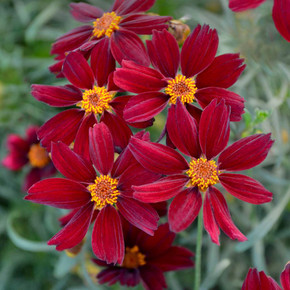

Please note your preferred ship date/week in the "Order Comments" section at checkout.
Otherwise, please allow 1-3 weeks to receive your order.
See the "Shipping" page under "Company Information" for our default ship dates based on hardiness zone.
We are unable to ship to any US Territories, AK, AZ, CA, CO, HI, ID, MT, NM, NV, OR, UT, WA, or WY
Evergreen perennial with bigger leathery leaves and early dark pink flowers. Pigsqueek 'Rotblum' ('Red Beauty' or 'Red Start') is an improved selection of B. cordifolia, introduced by Jelitto Perennial Seeds in 1978, with early flowering and very good fall and winter color - the leaves turn dark carmine red to brown-red.
The height without the leaves is about 8-10." It spreads very slowly on the surface via thick rhizomes.
This is a mountainous plant, so it appreciates cooler (partially shaded) spots or colder regions; even though it has been declared suitable for zones 3a to 9b, we recommend it for zones 3 to 6/7. Tolerates some drought, but is happier with regular-average rainfall moisture. This plant will tolerate dry shade too.
Otherwise this is a tough, long-lived, ground-covering perennial that is also deer and rabbit resistant. It attracts honey bees and probably other insects too.
Best for half-shade beds, full shade spots, woodland edges, woodland gardens, edges, rock gardens, shady banks of water bodies, and erosion control.
Blooming Time: March/April - beginning of May
Size: 15-18" and 12" wide
USDA Zones: 3a to 9b
Culture: Half/light or dappled shade to full shade, virtually any soil
Moisture Needs: medium-moist to medium-dry
Origin: the species of B. cordifolia originates from the mountains and rocky meadows of central Asia, from Afghanistan to China and the Himalayan region
Deer/Rabbit Resistant: yes / yes
Attracts Butterflies or Pollinators: honey bees
Attracts Hummingbirds: no
Pot Size: square 3.5" x 5" deep perennial pot
Pictures copyright: US Perennials
Plant combinations: Best in half shade, dappled shade, in cooler spots, woodland edge gardens, shade gardens, close to water features or pond/stream gardens. Meets in bloom and goes well with many later blooming spring bulbs and spring ephemerals. Looks ell with fine structures like grassy leaves - Carex (sedges), Hakonechloa, narrow-leaved Hosta, Iris cristata (and the Asian counterparts) or Tradescantia and also fine leaves of ferns!
Good companions can be also shorter cultivars of Amsonia, smaller Alchemilla, Anemone hupehensis (japonica), Aquilegia, Asarum, woodland Aster (Aster divaricatus etc.), Brunnera, Chelone lyonii, Dicentra, Disporum, Epimedium, Gallium odoratum, most of common hardy Geraniums, Helleborus, Heuchera and Heucherella, Geum, Lysimachia, Mellittis, Mukdenia, Nepeta subsessillis, Penstemon digitalis and calycosus (and hybrids), Phlox (x carolina and interspecific hybrids, Phlox divaricata, Phlox stolonifera, Phlox bifida), Podophylum, Polemonium, Polygonatum, Primula, Pulmonaria, Sedum ternatum, Stachys officinalis hybrids, Tiarella, Tricyrtis, Uvularia, Viola or Walsteinia.
Evergreen perennial with bigger leathery leaves and early dark pink flowers. Pigsqueek 'Rotblum' ('Red Beauty' or 'Red Start') is an improved selection of B. cordifolia, introduced by Jelitto Perennial Seeds in 1978, with early flowering and very good fall and winter color - the leaves turn dark carmine red to brown-red.
The height without the leaves is about 8-10." It spreads very slowly on the surface via thick rhizomes.
This is a mountainous plant, so it appreciates cooler (partially shaded) spots or colder regions; even though it has been declared suitable for zones 3a to 9b, we recommend it for zones 3 to 6/7. Tolerates some drought, but is happier with regular-average rainfall moisture. This plant will tolerate dry shade too.
Otherwise this is a tough, long-lived, ground-covering perennial that is also deer and rabbit resistant. It attracts honey bees and probably other insects too.
Best for half-shade beds, full shade spots, woodland edges, woodland gardens, edges, rock gardens, shady banks of water bodies, and erosion control.
Blooming Time: March/April - beginning of May
Size: 15-18" and 12" wide
USDA Zones: 3a to 9b
Culture: Half/light or dappled shade to full shade, virtually any soil
Moisture Needs: medium-moist to medium-dry
Origin: the species of B. cordifolia originates from the mountains and rocky meadows of central Asia, from Afghanistan to China and the Himalayan region
Deer/Rabbit Resistant: yes / yes
Attracts Butterflies or Pollinators: honey bees
Attracts Hummingbirds: no
Pot Size: square 3.5" x 5" deep perennial pot
Pictures copyright: US Perennials
Plant combinations: Best in half shade, dappled shade, in cooler spots, woodland edge gardens, shade gardens, close to water features or pond/stream gardens. Meets in bloom and goes well with many later blooming spring bulbs and spring ephemerals. Looks ell with fine structures like grassy leaves - Carex (sedges), Hakonechloa, narrow-leaved Hosta, Iris cristata (and the Asian counterparts) or Tradescantia and also fine leaves of ferns!
Good companions can be also shorter cultivars of Amsonia, smaller Alchemilla, Anemone hupehensis (japonica), Aquilegia, Asarum, woodland Aster (Aster divaricatus etc.), Brunnera, Chelone lyonii, Dicentra, Disporum, Epimedium, Gallium odoratum, most of common hardy Geraniums, Helleborus, Heuchera and Heucherella, Geum, Lysimachia, Mellittis, Mukdenia, Nepeta subsessillis, Penstemon digitalis and calycosus (and hybrids), Phlox (x carolina and interspecific hybrids, Phlox divaricata, Phlox stolonifera, Phlox bifida), Podophylum, Polemonium, Polygonatum, Primula, Pulmonaria, Sedum ternatum, Stachys officinalis hybrids, Tiarella, Tricyrtis, Uvularia, Viola or Walsteinia.
